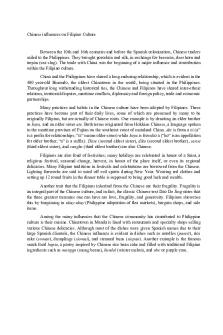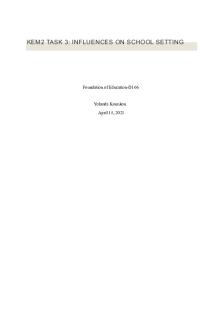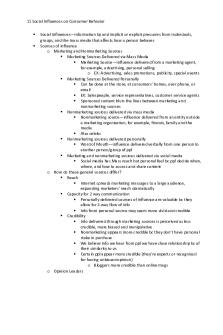Geographic Influences ON Voting Patterns PDF

| Title | Geographic Influences ON Voting Patterns |
|---|---|
| Course | Geography |
| Institution | University of Delhi |
| Pages | 5 |
| File Size | 166 KB |
| File Type | |
| Total Downloads | 209 |
| Total Views | 925 |
Summary
GEOGRAPHIC INFLUENCES ON VOTING PATTERNS Major factors involved are: 1. DEMOGRAPHICA. Regional disparities in voting: socio- economic political complexion has tremendous impact on political behaviour of an individual. Hence electoral districts have higher population density, thus carry more weightag...
Description
GEOGRAPHIC
INFLUENCES
ON
VOTING
PATTERNS
Major factors involved are: 1. DEMOGRAPHICA. Regional disparities in voting: socio- economic political complexion has tremendous impact on political behaviour of an individual. Hence electoral districts have higher population density, thus carry more weightage and that is why voters concentrated in larger districts feel more disenfranchised. B. RURAL-URBAN DISTRIBUTION OF VOTING PATTERNS- source of income, age differentials, sex ratio of election participation, average years of schooling are the major differentials affecting voting patterns. These ultimately lead to regional realignments of political parties & political decisions of voter. 2. SOCIO ECONOMIC STATUS AND VOTING PATTERNS: A. CLASS is a major cleavage here B. Such a cleavage makes the agenda of the party irrelevant and gives rise to an irrational voting behaviour. C. SOCIALIZATION
PROCESS:
according
to
Siegfried’s
GEOGRAPHY OF SUPPORT of party is linked with geography of membership of relevant sections of society. 3. PHYSICAL: A. WEATHER CONDITIONS B. JOURNAL OF POLITICS- voter turnout between 1987 & 2007 across 3000 countries correlated with 22,000 weather stations
C. Every 1” increase in rainfall correlated with 1% decrease in voter turnout.
GEOGRAPHIC INFLUENCES: To understand the above mentioned influences following operational models are taken into accounts: 1. STRUCTURAL EFFECTS: The NEIGHBOURHOOD EFFECT AND THE POLARISATION MODEL- spatial structural process whereby partisan nature of a person’s home district influences his or her voting decisions It reinforces voter segregation beyond socio-economic segregation. The core of the argument is that social networks, many of which are spatially clustered within households, families & neighbourhoods are the locales within which there is much discussion about political issues & some people may be convinced to change their views and party they support“CONVERSION BY CONVERSATION”. Major criticisms came from Dunleavy as the neighbourhood effect lacks adequate theoretical foundation. The original approach towards neighbourhood effect involved considering it as a residual after socio- economic variables. JOHNSTON’s APPROACH: Involved 3 stages: STAGE I- PREDICTION A national voter transition matrix is applied separately to each individual’s constituency and with the help of first election result an estimate of new voting patterns is produced which assumes that every constituency changes in same way as a country.
STAGE2Actual voting pattern can be assessed in second elections Now, actual- predicted= measures showing how each constituency differs from the national trend and hence neighbourhood effect infilled STAGE3if the neighbourhood effect operated the constituency different from national trends should be positively correlated to the level of party voting at first elections i.e. actual> predicted hence POLARISATION MODEL is established.
CANDIDATE VOTING AND CAMPAIGN EFFECTS: The friends and neighbours models postulates additional voting for a candidate in his or her home area. The involves a candidate’s supposed knowledge of the area & the constituents special knowledge of candidate (evident in multi- member constituencies)- DISTANCE DECAY MECHANISM It involves a highly behavioural approach For ex- Ireland- case of single Transferable votes in Galway west. Success of this strategy indicated by correlation between votes for each candidates & distance from the candidates home- per capita communication distance.
GENERAL CAMPAIGN STRATEGIES1. Patterns of expenditure, local issues raised in campaign literature and canvassing allow for assessment of differential campaign intensity by parties. 2. Prime ex- influence of expenditure by all parties on turnout in 1979 European elections.
3. Minghi and Rumley (1978) prudently conclude, the relationships in this field are “highly complex” and are not uncovered as simple effects. ENTROPY
MAXIMISATION
AND
THE
COMPONENTS
OF
ELECTORAL CHANGE: Johnston, Hay, Taylor (1982) considers all flows of votes and actual migration in and out of constituencies as well as changes in voter preferences. Identified 4 categories of voters and with both electoral and migration data estimated them using entropy approach. LOYAL STAYERS- neither move nor change votes LOYAL MOVERS- move but do not change votes SWITCHING STAYERS- change votes but do not move SWITCHING MOVERS- change both votes and district or regions Following hypotheses derived from above estimates. The neighbourhood effect hypothesis – a party will attract more SS the higher its initial vote. Differential Migration hypothesis- attract more LM the higher its initial vote. MIGRATION CONVERSION HYPOTHESIS- attract more SM the higher its initial vote. This is strongest hypotheses according to Johnston which was important for Labour, values and social credit parties but not for National party. But this approach will be successful only where data is available.
RELOCATION EFFECT: Coz (1970) analysed in case the number of migrant voters is large, they may succeed in changing existing viewpoint in the destination region & vice versa.
Therefore, residential relocations or migration of voters involve alteration in voting behaviour of immigrant voters....
Similar Free PDFs

Influences on Operations Essay
- 6 Pages

National Geographic
- 13 Pages

Chap 7 Group Influences on CB
- 23 Pages

Mandatory voting - Grade: 7.8
- 8 Pages

Voting theory notes
- 12 Pages
Popular Institutions
- Tinajero National High School - Annex
- Politeknik Caltex Riau
- Yokohama City University
- SGT University
- University of Al-Qadisiyah
- Divine Word College of Vigan
- Techniek College Rotterdam
- Universidade de Santiago
- Universiti Teknologi MARA Cawangan Johor Kampus Pasir Gudang
- Poltekkes Kemenkes Yogyakarta
- Baguio City National High School
- Colegio san marcos
- preparatoria uno
- Centro de Bachillerato Tecnológico Industrial y de Servicios No. 107
- Dalian Maritime University
- Quang Trung Secondary School
- Colegio Tecnológico en Informática
- Corporación Regional de Educación Superior
- Grupo CEDVA
- Dar Al Uloom University
- Centro de Estudios Preuniversitarios de la Universidad Nacional de Ingeniería
- 上智大学
- Aakash International School, Nuna Majara
- San Felipe Neri Catholic School
- Kang Chiao International School - New Taipei City
- Misamis Occidental National High School
- Institución Educativa Escuela Normal Juan Ladrilleros
- Kolehiyo ng Pantukan
- Batanes State College
- Instituto Continental
- Sekolah Menengah Kejuruan Kesehatan Kaltara (Tarakan)
- Colegio de La Inmaculada Concepcion - Cebu










